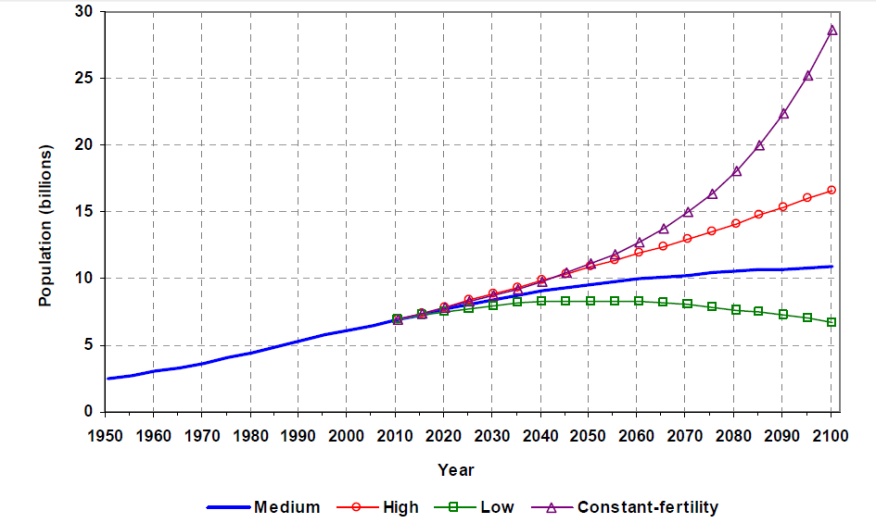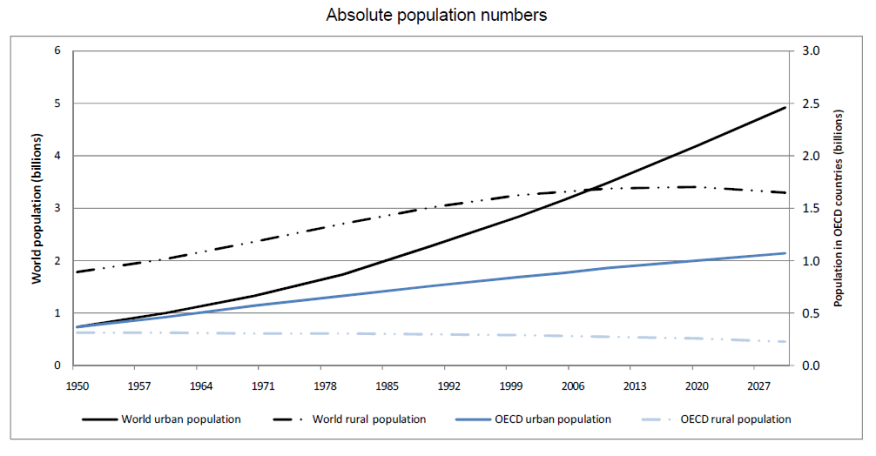
Road Network Operations
& Intelligent Transport Systems
A guide for practitioners!

Road Network Operations
& Intelligent Transport Systems
A guide for practitioners!
The greatest impact on transport demand arises from population growth, the increase in number of households and their location and associated levels of economic activity. A key challenge is to predict likely changes in living and mobility patterns. An elusive goal - in the interests of transport demand management and environmental sustainability - is to try to decouple the close link between economic growth and increased transport demand. Possible ways of doing this, which futures work needs to address are:
This may involve looking at areas such as:
In June 2013 the Population Division of the Department of Economic and Social Affairs at the United Nations published its predictions for World Population until the end of the 21st Century (See Figure below).The medium range forecast was for an increase of over 50% by the end of the century (7.2bn in 2013 to 8.1bn in 2025; 9.6bn in 2050; 10.9bn in 2100).

Population growth is estimated to be highest in developing economies at over 60% (5.9bn in 2013 to 9.6bn in 2100), whereas the population of the developed world is thought likely to remain fairly static, with an increase of less than 3% (1.25bn in 2013 to 1.28bn in 2100).
The characteristics of the profile of the population, in terms of age, gender, ethnic and cultural composition, personal mobility, where and how they live – will be affected by migration and seasonal fluctuations – and will all impact on transport demand, mobility patterns and preferences, infrastructure needs and services. The number of people of core working age (25-59) in developing economies, for example, is predicted to increase by 57% in (2.6bn in 2013 to 4.1bn in 2100). In the developed world, the corresponding population is predicted to peak in 2013 and reduce by 17% by the end of the century (608m in 2013 to 504m by 2100).
Further information on population changes is available in the report for the United Nations’ Department for Economic and Social Affairs ‘World Population Prospects – The 2012 Revision’ This presents the UN’s updated population estimates and projections – and synthesises them with the findings of recent demographic surveys from around the world.
A key trend in the distribution of the world’s population in the 21st Century is greater urbanisation. A report commissioned by the Organisation for Economic Cooperation and Development (OECD) showed that for OECD countries, by 1950, the urban population was already larger than the rural population (See below). Wider world trends towards urbanisation - reached the same milestone in 2006. The UN predicts that by 2050, 70% of the world’s population and 86% of the population of OECD countries will live in cities. Today there are 33 ‘megacities’ with populations in excess of 10 million people, 11 of which have more than 20 million people.

This huge growth in urbanisation increases the demand for housing, associated utilities and services including transport infrastructure, public transport, vehicle parking and better integration between the urban, inter-urban and national transport networks. In turn, this leads to increased pressure on land use and development within or around urban areas contributing to land shortages, urban sprawl and decline of the agricultural sector in rural areas. The issues will be how to service accessibility and mobility for these communities - or find solutions which reduce travel dependency.
Useful information on urbanisation is provided in the OECD report ‘Trends in Urbanisation and Urban Policies in OECD Countries: What Lessons for China’ It synthesises trends in urbanisation and urban policies in OECD countries – and one of its key messages for China is that a successful urban development strategy should build upon an urban region’s own characteristics - not simply its infrastructure, but also the knowledge and skills of its workers.
The Green and ITS book (edited by SWECO-ITS) describes how Stockholm is using ITS to reduce environmental impact from transport and the development of a true sustainable transport system.
A major challenge arising from changing demographics is the increasing proportion of the population living into old age. This is a result of increasing life expectancy linked to declining mortality. A major study by the United Nations, predicted that the percentage of the population over 60 years of age would increase by 13% over the 100 year period between 1950-2050 (from 8% in 1950; to 10% in 2000; to 21% in 2050). This ageing population will affect transport both directly and indirectly through factors such as the make-up of the workforce, the numbers of youthful and ageing vehicle drivers. There will also be an increased demand for improved accessibility and greater mobility assistance for those less able to travel independently, new technologies to enable them to drive safely, and alternative services if this is not affordable or possible.
Further information on the ageing population is available from the United Nations’ Department of Economic and Social Affairs’ 2002 report ‘World Population Ageing 1950-2050’. It describes global trends in population ageing and addresses characteristics of the ageing process in different regions and countries. The aim is to assist policy makers to define, formulate and evaluate goals and programmes - and to raise public awareness and support for any policy changes needed.
The demographic changes will require efficient management of large, urban transport networks and their connections with national networks and international gateways. Quick to implement ITS technologies provide flexible solutions to rapid change and have a key role to play alongside the lengthier process of planning, implementing and adapting large infrastructure projects (such as major roads, metros, railways and airports). This provides opportunities for market-driven ITS applications for consumers. For transport authorities, the key consideration is to be aware of anticipated changes in travel patterns in the short-to-medium term (the 10 to 15 years which mirrors the typical lifecycle of ITS technology) and to design transport management systems around those changes.
Information and control systems must serve, and be understood by, all sections of the population if they are to be effective, inclusive and acceptable. They also need to be adapted to the needs of travellers with disabilities. Presentation of information in appropriate sensory forms (audible, visual, tactile) should therefore form a key element of the design of future ITS systems (See Human Factors).